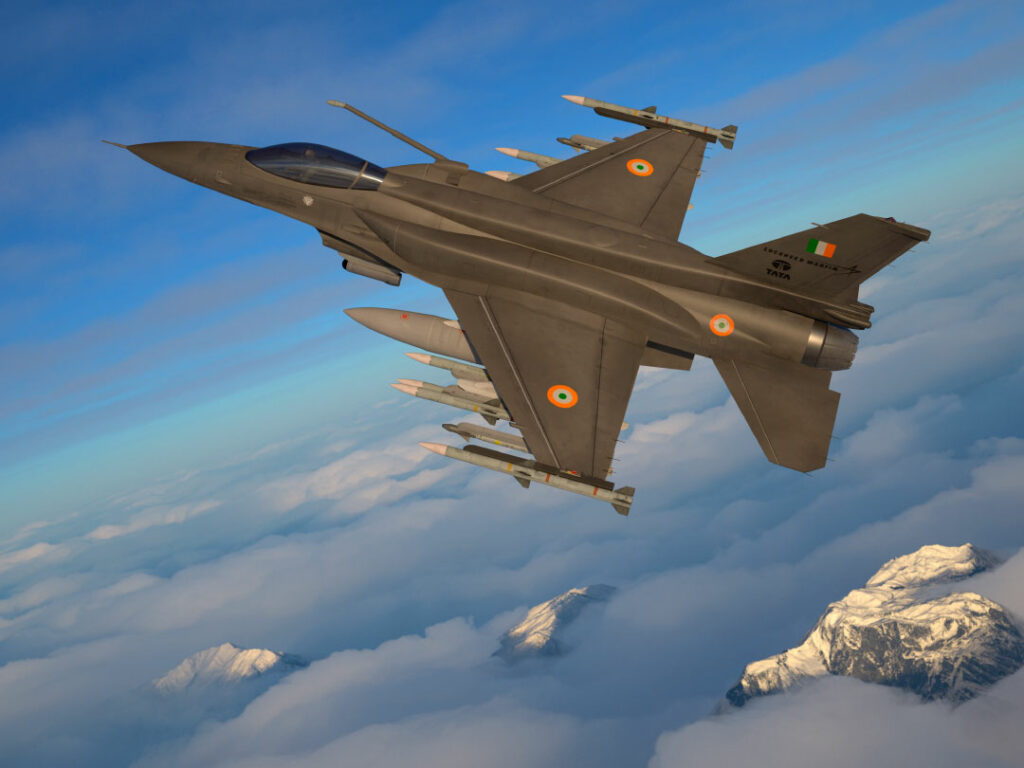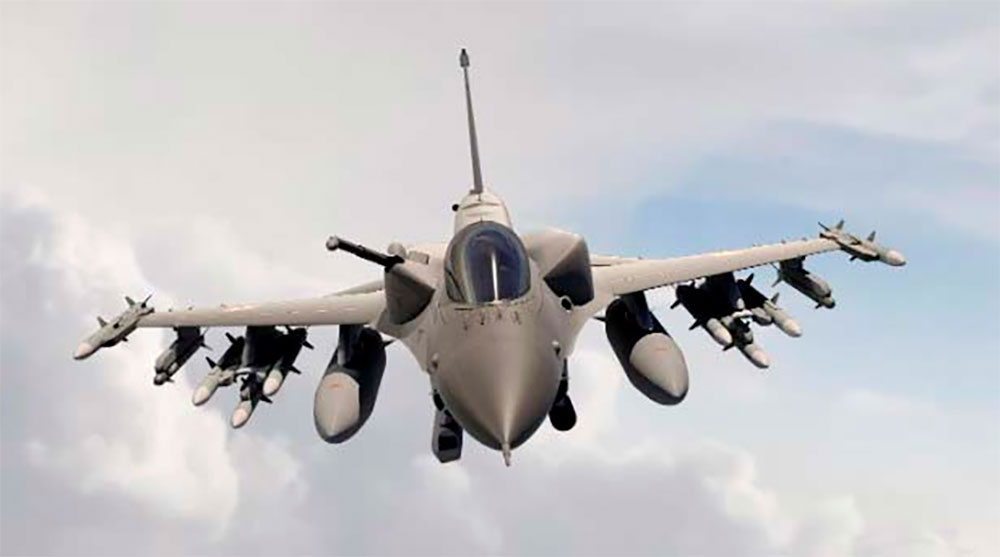The Lockheed Martin F-21 is a 4.5-generation multirole fighter aircraft, an advanced variant of the F-16, tailored for the Indian Air Force with enhanced avionics, increased payload capacity, and extended operational range.
The Lockheed Martin F-21 is an advanced iteration of the F-16 Fighting Falcon, specifically designed to meet the operational requirements of the Indian Air Force (IAF). This 4.5-generation multirole fighter incorporates state-of-the-art avionics, including an Active Electronically Scanned Array (AESA) radar and a modernized glass cockpit. Enhanced structural features such as conformal fuel tanks and an extendable refueling probe provide increased range and mission endurance. The F-21 offers a 40% increase in air-to-air weapons carriage compared to previous F-16 models, utilizing a triple-rail launcher system. Designed for compatibility with both probe-and-drogue and boom aerial refueling methods, the aircraft ensures operational flexibility. A collaborative production initiative between Lockheed Martin and Tata Advanced Systems aims to manufacture the F-21 in India, aligning with the country’s ‘Make in India’ defense strategy.
History of Development
In the early 1970s, the United States recognized the need for a lightweight, multirole fighter aircraft to complement its existing fleet. This realization led to the development of the F-16 Fighting Falcon, which made its maiden flight on January 20, 1974. Over the decades, the F-16 underwent numerous upgrades, solidifying its reputation as a versatile and reliable combat aircraft.
Fast forward to the 2010s, the Indian Air Force (IAF) sought to modernize its fleet to address emerging regional security challenges and replace aging aircraft. In response, Lockheed Martin introduced the F-21 on February 20, 2019, at the Aero India air show. This aircraft was specifically tailored to meet the IAF’s operational requirements, offering advanced technologies and capabilities. The designation ‘F-21’ signifies a new chapter, differentiating it from previous F-16 variants and highlighting its unique features designed for India.
The development of the F-21 was not merely an upgrade but a comprehensive redesign to incorporate fifth-generation technologies into a proven airframe. Lockheed Martin collaborated closely with Tata Advanced Systems, aligning with India’s ‘Make in India’ initiative. This partnership aimed to establish a robust defense manufacturing ecosystem within India, ensuring that the production of the F-21 would bolster local industry and create high-skilled jobs.
The F-21’s development also considered interoperability with India’s existing military infrastructure. Features such as an extendable refueling probe compatible with the IAF’s Russian-made aerial refueling tankers were incorporated, ensuring seamless integration into current operations. Additionally, the aircraft’s avionics and weapon systems were designed to accommodate both Western and indigenous technologies, providing flexibility in mission planning and execution.
While the F-21 draws inspiration from the F-16 lineage, it stands as a distinct entity, embodying advancements that position it as a 4.5-generation fighter. Its development reflects a strategic vision to enhance India’s air combat capabilities through technological innovation and industrial collaboration.

Design
The Lockheed Martin F-21 showcases a blend of time-tested aerodynamic design and modern technological enhancements, resulting in a multirole fighter optimized for versatility and performance.
Airframe and Aerodynamics:
Retaining the classic lines of the F-16, the F-21 features a sleek fuselage measuring 49.4 feet (15.05 meters) in length, with a wingspan of 32.6 feet (9.95 meters) and an overall height of 16.0 feet (4.88 meters). The airframe incorporates advanced composite materials, reducing weight and enhancing structural integrity. Conformal fuel tanks are seamlessly integrated into the upper fuselage, extending the aircraft’s range without compromising its aerodynamic profile. These tanks maintain the F-21’s agility by preserving its low-drag configuration.
Cockpit and Avionics:
The F-21’s cockpit is designed with pilot efficiency and situational awareness in mind. A large-area, full-color touchscreen display dominates the instrument panel, providing real-time data and intuitive interface controls. This modernized glass cockpit layout reduces pilot workload and enhances mission effectiveness. The avionics suite includes an AN/APG-83 Active Electronically Scanned Array (AESA) radar, offering nearly twice the range of mechanically scanned array radars and the capability to track multiple targets with high precision. Additionally, the aircraft is equipped with a Long Range Infrared Search and Track (IRST) system, enabling passive detection of threats without revealing the aircraft’s position.
Propulsion and Performance:
Powering the F-21 is a single General Electric F110-GE-129 afterburning turbofan engine, delivering approximately 18,000 pounds (8,165 kilograms) of thrust in dry conditions and up to 30,000 pounds (13,608 kilograms) with afterburner. This propulsion system enables the aircraft to achieve a maximum speed of 1,317 miles per hour (2,120 kilometers per hour), or Mach 2.05, and a service ceiling of 50,033 feet (15,250 meters). The engine’s design emphasizes reliability and ease of maintenance, crucial for sustained operational readiness.
Refueling and Range:
The F-21 is compatible with both probe-and-drogue and boom refueling systems, a rare feature among fighter aircraft. This ensures operational flexibility, allowing it to refuel from various aerial tankers, including those used by the Indian Air Force (IAF) and NATO allies. With internal fuel capacity and conformal tanks, the F-21 has a combat radius of approximately 800 nautical miles (1,482 kilometers) and a ferry range of 2,300 nautical miles (4,260 kilometers) without refueling.
Weapons and Hardpoints:
The F-21 has nine hardpoints, including two wingtip stations, three under each wing, and a centerline station. It can carry a 40% greater air-to-air weapons load than previous F-16 variants due to its triple-rail missile launcher system. The aircraft is equipped with an M61 Vulcan 20mm rotary cannon, alongside support for air-to-air and air-to-ground munitions, including the AIM-120 AMRAAM, AIM-9X Sidewinder, BrahMos-NG, and precision-guided bombs.
Performance
The Lockheed Martin F-21 integrates modernized propulsion, aerodynamic efficiency, and mission adaptability, ensuring superior performance in diverse combat scenarios.
Powerplant and Speed
The F-21 is powered by a General Electric F110-GE-129 afterburning turbofan engine, generating 29,588 pounds (13,423 kilograms) of thrust with afterburner. This allows the aircraft to reach a maximum speed of Mach 2.05 (2,120 km/h or 1,317 mph) at high altitude.
Range and Endurance
The internal fuel capacity of the F-21 is 7,000 pounds (3,175 kilograms), and with conformal fuel tanks and external drop tanks, its range extends to 2,300 nautical miles (4,260 kilometers). This significantly enhances loiter time and strike capability without requiring frequent refueling.
Maneuverability and Combat Agility
With a thrust-to-weight ratio exceeding 1.0 when lightly loaded and an instantaneous turn rate of approximately 26 degrees per second, the F-21 maintains high agility. The structural limit of +9g ensures the aircraft can sustain high-stress combat maneuvers. The fly-by-wire control system and relaxed static stability enhance responsiveness.
Comparison with Competing Aircraft
The F-21 directly competes with Dassault Rafale, Saab JAS 39 Gripen-E, and Boeing F/A-18 Super Hornet in India’s fighter acquisition programs. Compared to the Rafale, the F-21 has a greater weapons payload capacity and extended range, but lacks twin-engine redundancy. Against the Gripen-E, the F-21’s higher thrust output and superior avionics suite provide a distinct advantage in BVR (Beyond Visual Range) engagements.

Variants
The F-21 is based on the F-16 Block 70/72, incorporating custom modifications for Indian Air Force (IAF) requirements.
F-21 Standard Configuration
- Radar: AN/APG-83 AESA Radar
- Weapons Compatibility: Western and Indian munitions
- Extended Range: Conformal Fuel Tanks (CFTs)
- Avionics: Upgraded digital flight systems and glass cockpit
- Refueling Capability: Boom and probe-and-drogue refueling
F-21 Export Configuration
- Designed for potential international sales, adaptable to other air forces with localized weapon systems integration.
Military Missions
The F-21 is designed to conduct air superiority, ground strike, reconnaissance, and electronic warfare missions.
Air Superiority and Beyond Visual Range Combat
The F-21 utilizes the AIM-120 AMRAAM and AIM-9X Sidewinder, capable of engaging multiple targets using the AN/APG-83 AESA radar. The IRST (Infrared Search and Track) system enables passive detection of stealth aircraft.
Strike Missions
The F-21 can carry laser-guided bombs (LGBs), Joint Direct Attack Munitions (JDAMs), and BrahMos-NG supersonic cruise missiles. The high payload capacity enhances its ground attack capabilities.
Suppression of Enemy Air Defenses (SEAD)
Equipped with AGM-88 HARM missiles, the F-21 is capable of neutralizing enemy radar systems and air defense networks.
Reconnaissance and Electronic Warfare
With electronic warfare pods, data-link connectivity, and reconnaissance sensors, the F-21 provides real-time battlefield intelligence.
Operational Deployment
Though the F-21 was developed for India, the Indian Air Force has yet to finalize its acquisition. The aircraft competes with the Rafale and Tejas Mk2 for future fleet expansion.
The Lockheed Martin F-21 is an advanced 4.5-generation fighter tailored for India’s defense needs. It combines the combat-proven airframe of the F-16 with modernized avionics, extended range, and enhanced weapon capabilities. While not a fifth-generation aircraft, it offers affordable operational costs, high mission adaptability, and strong deterrence capabilities. The F-21’s strategic appeal lies in its ability to integrate seamlessly into India’s defense ecosystem, making it a viable contender in the MRCA competition.
Back to the Fighter Jet section.